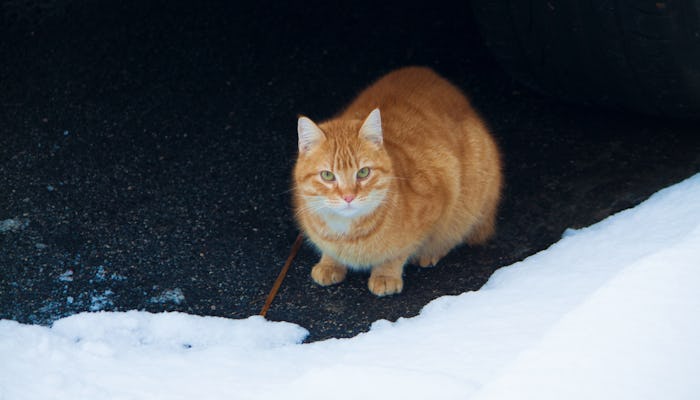Life

Here's When It's Officially Too Cold & Dangerous For Your Cat To Be Outside
The winter season presents serious dangers for our furry friends, and outdoor and indoor pets alike need some extra TLC this time of year. Frostbite, anti-freeze, and the surprisingly dangerous hoods of cars can all make your winter wonderland an inhospitable place for those exploring it on four legs. If your cat likes to roam the great outdoors, you might wonder, at what temperature is it dangerous for a cat to go outside? According to PetMD, the number depends, in part, on the health and habits of the cat. Generally speaking however, if you wouldn't feel safe outside, then your cat isn't, either.
"During the winter months, the number of calls received by the Pennsylvania SPCA’s Humane Law Enforcement Department concerning animals being left outside spikes," writes the Pennsylvania SPCA in an email to Romper. Pennsylvania takes winter very seriously, and their Humane Law Enforcement Team even ventures out in frigid temperatures to enforce cruelty codes. "Despite their fur coats, dogs and cats are susceptible to cold temperatures just like people. While dogs and some cats may like to spend time outside in all kinds of weather, we strongly recommend that pets' time outside is limited during these extreme temperatures. If you're cold, a good rule of thumb is that your pets will be cold, too."
However, if you're the owner of an indoor/outdoor cat, and you're looking for a specific number, Jennifer L. Summerfield, DVM CPDT-KA, of Brown Veterinary Service in Wayne, West Virginia, tells Romper in an interview that temperatures below 45 degrees Fahrenheit aren't ideal for feline friends.
"It's always a little bit hard to give super general guidelines, because some of it is going to depend on the cat’s body condition and whether they’re acclimated to being outside or not," Summerfield explains. "But less than 45 degrees, I tell my clients it's best to keep cats inside if they can." While she notes that it's not necessarily dangerous for a cat to be outside below that temperature as long as they have an insulated shelter to go to, it's not comfortable, either.
What about neighborhood cats, community cats, and strays? If you or your kids are interested in lending them a helping hand, consider building a few DIY cat shelters, like this one from Neighborhood Cats, out of cardboard, Tupperware, or other household materials. Distribute them throughout the neighborhood for a family-friendly good deed.
"The biggest thing is you want the shelter to be dry and protected from the wind," says Summerfield, whose book Train Your Dog Now! comes out in March 2018. She goes on to note that a shelter can make a difference to stray animals even when temperatures drop below zero — though it's certainly not ideal for any domestic animal to be out in such weather. "I’ve definitely had clients who make shelters like that and leave them on their porch for neighborhood cats and stray cats, and the cats do seem to be super appreciative — especially here in West Virginia, where its in the single digits," she says.
Still, when it comes to your cat, it's best to get them inside in winter months. After all, even a relatively warm day can take a turn for the worse when the wind picks up. "We always recommend keeping pets indoors whenever possible. If it’s cold outside to you, then it’s cold outside to your pets," explains Gretchen Pressley of the Pikes Peak Region Humane Society in Colorado Springs, Colorado. "And if there are outside cats in your neighborhood, we recommend banging on the hood of your car before starting it up in the morning." After you turn your car off, the hood remains warm — a tempting place to huddle for any stray or community cat. Banging on the hood can prevent outdoor cats from being injured.
Additionally, Pressley advises cleaning up anti-freeze spills immediately, because anti-freeze is extremly poisonous to cats, dogs, and wildlife in general.
In short, your cat may seem like a feline superhero, but she is just as susceptible to cold temperatures as you are — and that goes double for kittens and elderly animals. Even indoor cats can use a little extra looking after in the bitter nights of winter. According to Pressley, you should always make sure they have a warm place inside to sleep, away from chilly drafts. Personally, my cat never fails to find the coziest spot by the fire.
Check out Romper's new video series, Romper's Doula Diaries:
Watch full episodes of Romper's Doula Diaries on Facebook Watch.